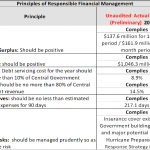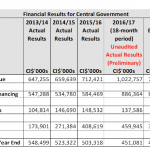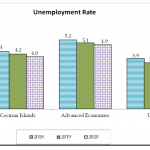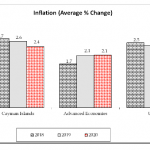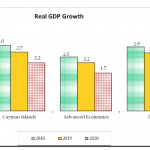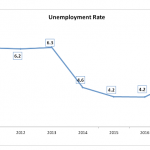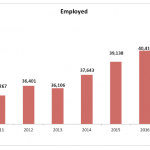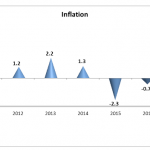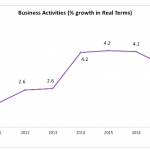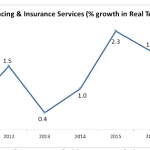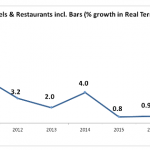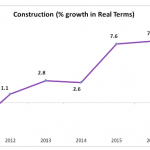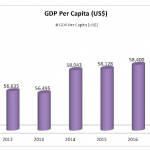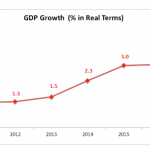Cayman Islands Chamber of Commerce’s Economic Forum Address by the Honourable Roy McTaggart, JP
 Thursday 24 May 2018 at 12:30 pm Kimpton Seafire Resort & Spa
Thursday 24 May 2018 at 12:30 pm Kimpton Seafire Resort & Spa
Opening
Good Afternoon Colleagues. It is my pleasure to speak at this Forum and I thank Paul for extending the invitation for me to provide an update on the current state of Cayman’s economy, the economic projections over the next three years and the Government’s current fiscal position.
In so doing, I believe that there will be something of interest to everyone in this room. So…let’s talk Cayman!
The Current State of Cayman’s Economy
Gross Domestic Product (GDP)
For 2017, indicators show that Cayman’s GDP grew in real terms by 2.9 per cent. This comes on the back of similar growth of 3.0 per cent in 2015 and 3.1 per cent in 2016 and is significantly higher than the forecast in early 2017 of 2.1 per cent and the updated projection of 2.4 per cent as of the third quarter of 2017.
The GDP growth of 2.9 per cent is also more robust than the estimated growth of the US and the advanced economies as a group in 2017 of 2.3 per cent.
Adjusted for inflation, the estimated GDP of the Islands reached $2.8 billion at end 2017, or $3.1 billion in 2017 prices.
This latter figure of $3.1 billion, represents a per capita income of approximately $49,748 or US$59,697.
Based on the latest comparative data from the International Monetary Fund (IMF), this places us the 7th highest GDP in the world, ahead of many OECD countries. In comparison, the US ranked 8th with a per capita income of US$59,501 in 2017.
Growth by Industry
Growth in 2017 was broad-based as all major industries showed positive growth.
The most dynamic is the construction sector, with its gross value added increasing by 7.2 per cent for 2017, following similar increases of 7.6 per cent in 2015 and 7.9 percent in 2016.
The construction sector’s growth reflects the infrastructural capacity of the Islands keeping pace with the demand for residential, commercial and public facilities – arising from a higher population base which is estimated at 63,415 at the end of 2017.
Overall, tourist arrivals reached 2.15 million in 2017, higher by 2.4 per cent compared to 2016. Services related to tourism were on recovery mode in 2017 after two years of modest growth. The all-important stayover tourist arrivals were up by 8.5 per cent. Growth in stay-over tourist arrivals benefited from the temporary closure of some markets in the region due to hurricanes Irma and Maria.
Consequently, the sector comprising of hotels, restaurants and bars is estimated to have its combined value added rising by a similar 8.5 per cent in 2017.
The largest sector of the economy is the financial and insurance services industry that consists mainly of domestic banking and insurance services. This industry directly contributes 41 per cent of GDP and grew by an estimated 1.4 per cent in 2017.
The anaemic performance of this sector of the economy may have been partly impacted in 2017 by the decline in the demand for domestic credit by the Public Sector (primarily reflecting the absence of any Government borrowing), as well as by businesses in the private sector.
The last time the Government borrowed money was in April 2011 and since then all of Government’s expenditures have been met by its Operating Revenues.
The professional, scientific and technical services sector which is comprised mainly of legal and accounting services, grew by 3.6 per cent in 2017. This industry directly contributes 14.6 per cent to total GDP, the second largest sectoral contribution to GDP.
Collectively, these 2 sectors contribute 55.6 per cent to our GDP, and it is on this basis that we acknowledge that the “financial services” industry contributes more than 50 per cent to the Islands’ GDP.
Government adopts descriptive classifications for the components of GDP based on the International Standard of Industrial Classification.
Consumer Prices
Following the recovery of oil prices, as well as other commodity prices in the international market, the inflation rate turned positive in 2017 at 2.0 per cent after two consecutive years of deflation.
Housing rentals also started to recover from their persistent downtrend in prior years. The sustained growth in population generated an upward pressure on the demand for housing.
Employment
The robust growth in the domestic economy spurred an increase in demand for labour. Total employment at the end of 2017, reached 40,856 persons which is 1.1 per cent higher compared to 2016.
Given the estimated growth in GDP of 2.9 per cent, there was a strong growth in overall productivity of the workforce by 1.8 per cent in 2017. GDP per employee is estimated in real terms at $66,723.
The majority of jobs in the economy in 2017 were provided by large-scale enterprises with 50 or more employees and, by micro-enterprises with 1-5 employees. They respectively account for 30.4 per cent and 25.1 per cent, of total employment.
Despite an increase in the number of jobs provided in 2017, the number of persons seeking jobs was much greater and consequently the overall unemployment rate increased to 4.9 per cent in 2017 from 4.2 per cent in 2015 and 2016 as more people returned to the labour pool to seek employment because of improvement in employment prospects.
The improvement in employment in 2017 can be traced to:
1.an improved construction activity with project approvals that were a record high of $798.7 million;
2.an increase in the number of new partnerships registration, stock exchange listings and new company registrations;
3.an increase in stay-over tourist arrivals by 8.5 per cent in 2017 which can be traced to arrivals from the American and Canadian markets – which grew by 13.4 per cent and 6.4 per cent, respectively; and
4.the growth in the utilities sector where electricity consumption rose by 2.5 per cent as the consumer base grew while water consumption increased by 2.8 per cent.
The Government sees these improvements in the employment rate as a continuing trend and believes it is justified in that viewpoint.
Key Drivers, Initiatives and Policies Aiding the Strength and Growth of Cayman’s Economy
The current strength and growth of Cayman’s economy can be attributed primarily to the growing diversification of the economy in addition to our successful tourism and financial services industries.
The key drivers of these sectors include:
1.the political stability of the Islands;
2.the fiscal strength of the Government; and
3.a good relationship with the UK Government – at least up until recently.
Compared to other offshore financial centres, Cayman’s competitive advantages are:
1.having an excellent pool of professionals (accountants, lawyers, bankers, hedge fund administrators);
2.the Government being legally obliged to practice prudent fiscal management – which provides great certainty for business operations;
3.having a high standard of living that encourages professionals to want to live and work in the Islands;
4.no restrictions on the free movement of capital, no foreign exchange controls and no restrictions on the ownership of real estate;
5.no taxes or levies imposed on repatriation of profits to jurisdictions outside the Cayman Islands;
6.excellent communication links between the Islands and the rest of the world;
7.excellent direct airline services with North America and the UK; and
8.a robust and independent judiciary system that is grounded in UK common law.
Key Reason for the Current Strength and Growth of Cayman’s Economy
The tremendous improvement in Government’s financial performance and position since 2013 has given foreign investors and local business owners great confidence that their investments in the Cayman Islands will be safe and, will NOT be dented by annual increases in Government’s income measures such as increases to fees/duties and charges – which would undermine the key requirement for business to flourish, certainty.
In fact, quite the opposite, since 2013 Government has actually reduced certain import duties and fees – which are aimed at providing relief to the general population and business entities.
I will talk some more about the reduced import duties and fees further on.
Economic Projections for the Next Three Years
GDP
The GDP growth of the Cayman Islands, in 2018, is projected at 3.0 per cent which is slightly higher than the estimated growth for 2017 of 2.9 per cent.
Further growth is projected at 2.7 per cent in 2019 and 2.2 per cent in 2020. This outlook for 2018 to 2020 partly reflects the potential impact of the projections of the IMF for the US and the advanced economies.
The construction sector is expected to continue leading the economic expansion in 2018 and continuing through 2020.
Approved Public Sector projects such as the on-going expansion of the Owen Roberts International Airport, the Linford Pierson highway, Long-Term Residential Mental Health Facility, Solid Waste Management System and the preliminary work on the George Town Cruise Berthing facility, are indications of the Government’s commitment to improving infrastructure capacity to facilitate development and further economic growth.
Notwithstanding Public Sector projects occurring, growth over the medium-term is expected to be driven in large part by the private sector with recently completed and forthcoming projects that will increase the accommodation capacity for tourist arrivals and other commercial activities.
The approval for the construction of a new hotel at the old Pageant Beach location is an indication of the type of developments that are being undertaken by the private sector. Other significant projects approved in 2017 and expected to contribute to construction growth over the medium term include: the continued development of Camana Bay including the expansion of the underpass as well as the construction of a new supermarket. The sector is also expected to be boosted by the construction of a new Hotel by NCB Investments as well an eighty one unit apartment complex by Periwinkle Ltd.
Construction is forecasted to grow by 8.4 per cent in 2018, 10.5 per cent in 2019 and 6.8 per cent in 2020.
Additionally, with the IMF projecting strong growth for the US economy in 2018 and beyond, the demands for the Islands’ services are expected to remain strong over the medium term. The US GDP growth is expected at 2.9 per cent in 2018 and 2.7 per cent in 2019 arising mainly from the impact of the tax reforms. Moderate growth of 1.9 per cent is forecasted for 2020 due to the short-term nature of some provisions.
Consistent with the above forecasts, growth in financing and insurance services is projected to increase by 1.9 per cent in 2018, 1.6 per cent in 2019 and 1.5 per cent in 2020.
Further, the strong new company registrations in 2017 is an indication that the Cayman economy remains a destination of choice. Growth in business services, mainly legal and accounting services, which is projected to increase by 3.4 percent in 2018, 3.2 per cent in 2019 and 2.4 per cent in 2020, is expected to bolster the projected GDP growth for the next three years.
Similarly, the hotels and restaurant sector is foreseen to record accelerated growth in 2018 of 9.0 per cent. With the airport modernization and growth in accommodation capacity, the sector is projected to further expand at a sustainable rate of 4.7 per cent and 4.5 per cent in 2019 and 2020, respectively.
Consumer Prices
With stronger demand for domestic goods and services, Cayman’s annual inflation is projected at 2.7 per cent in 2018, 2.6 per cent in 2019 and 2.4 per cent in 2020.
This is also in line with projections for the US, our main source of consumption goods. Nonetheless, the overall price movement is expected to remain amongst the most stable in the region.
Employment
Contingent on the sustained strong recovery of the labour-intensive tourism services as well as the implementation of planned infrastructure projects, greater employment opportunities are expected to push down the unemployment rate.
The current estimated unemployment rate for 2018 is 4.4 per cent. This is expected to improve to 4.2 per cent in 2019 and 4.0 per cent in 2020.
Government’s Prudent Fiscal Management
Government continues to manage the fiscal affairs of the country in a prudent and responsible way, demonstrating our commitment to manage our financial affairs in a manner that achieves long term growth, stability and sustainability.
Operating Revenue
Since July 2013, Central Government’s operating revenues have grown steadily from $647.3 million in 2013/14 to an unaudited total of $1.0 billion for the 18-month period ending 31 December 2017.
The rising revenues are the result of economic growth that was spurred in large part by the specific policy decisions of this Administration to:
not introduce new revenue measures that would increase the tax burden; and
reduce taxes in those areas that would yield the greatest impact by encouraging economic growth while also reducing the cost of doing business and the cost of living where possible for residents.
The Government’s commitment to our people is simple: we will not introduce any new coercive revenue measures during our term in office that ends in 2021. This gives strong comfort, certainty and confidence to the private sector to make investments with the knowledge that Government will not throw any curve balls their way.
The areas that Government has reduced import duties and fees include:
1.Import Duty on Diesel used by CUC for the generation of electricity. Duties were reduced from 75 to 25 cents per imperial gallon which is equivalent to approximately $16.8 million in revenue that the Government is forsaking annually.
2.Import duty rates on merchandise for licensed traders were also reduced from 22 per cent to 20 per cent. This reduction is equivalent to approximately $4 million in revenue that the Government is forsaking annually.
3.Trade and Business Licence Fees for small businesses were reduced. Businesses licensed to operate in George Town and West Bay now receive a 25 per cent discount on their trade and business licence fees, while businesses in Bodden Town, North Side, East End and Little Cayman receive a 50 per cent discount and businesses in Cayman Brac receive a 75 per cent discount.
4.Incentives that are currently in place for the Sister Islands include:
a.a 100 per cent import duty waiver on building materials imported to Cayman Brac and Little Cayman;
b.a 100 per cent import duty waiver on diesel fuel for Cayman Brac Power and Light;
c.a 12.5 cents per gallon import duty rate (or a duty rate waiver of 83.3 per cent) on the importation of motor gasoline to Cayman Brac; and
d.a 100 per cent waiver on stamp duty for the purchase of land in Cayman Brac, providing it is developed within two years.
5.There are no duties on school supplies and uniforms.
6.Import duties on electric motorcycles, electric segways and electric cars, were reduced to a 10 per cent rate and
7.Import duties on hybrid motorcycles and cars were reduced to a 15 per cent rate.
Operating and Financing Expenditures
Government has taken decisive actions to reduce operating and financing expenditure where possible and to strictly control any growth in expenses.
Since July 2013, financing costs have decreased steadily as Central Government debt balance has declined at an average of $26.6 million per year.
This reflects the following important factors:
1.Government has not borrowed in seven (7) years;
2.Debt principal has been reduced by Government’s repayment of debt – sometimes ahead of the repayment due dates; and
3.Government’s renegotiation of the interest rates with respect to several of its loans has secured lower interest rates, and reduced the amount of interest payable each year.
Government has also restricted the level of capital investment funding to surplus cash generated from operating activities whilst remaining cognizant that there is a delicate balance to be struck between the containment of capital investment spending and the need for adequate investment in a growing economy such as ours.
Operating Surplus
Coupled with the improved operating revenues and the Government’s aggressive management of expenditures, since July 2013, Government has achieved operating surpluses of over $100 million in each financial year. Surpluses increased from $104.8 million in 2013/14 to an unaudited actual of $137.6 million for the 18-month period ending 31 December 2017.
The substantial cash flows from operating surpluses have enabled the Government to build and maintain significant cash reserves – which are a key component of ensuring compliance with the Principles of Responsible Financial Management and the Framework for Fiscal Responsibility which are set out in the Public Management and Finance Law.
Bank Balances
Growing revenues with economic growth, reducing operating and financing expenses and containing capital investments have contributed to the steady increase in Central Government’s bank balances from $173.9 million at 30 June 2014 to an unaudited balance of $459.9 million at 31 December 2017.
Debt Balances
Government’s aggressive debt management strategy of no new borrowings, accelerated payments and debt restructuring has yielded a $97.4 million reduction in Central Government debt from $548.5 million at 30 June 2014 to an unaudited balance of $451.1 million at 31 December 2017.
During the 2018 and 2019 financial years, the Government has to manage the November 2019 repayment of the 2009 Bond of US$312 million coupled with the statutory need to maintain a minimum operating cash balance equivalent to 90 days of Operating Expenditure, and continue the delivery of services and capital investment projects.
In November 2019, when the 2009 Bond becomes due, our forecasts suggest that the Government may need to borrow up to $153.0 million or 58% of the amount of that Bond to refinance it into an amortising debt instrument. Core Government’s Debt is then forecast to be $286.7 million at 31 December 2019.
The Government concluded that it was not prudent to substantially deplete its entire cash balances in order to completely avoid external borrowing altogether in 2019.
However, as we approach November 2019, the Government will reassess its required level of borrowing after a robust review of cash balances and forecast results to 31st December 2019.
With a Debt-to-GDP ratio of 14.5 per cent in 2017, the Government’s fiscal strategy regarding borrowing is grounded in our desire to avoid future generations of Caymanians with the costs of the decisions made by this generation. Ideally, we want to minimize borrowings as much as possible so that when it is necessary to borrow for capital investments, we can match the repayment over the expected lifespan of the investment.
Compliance with Principles of Responsible Financial Management
The Government’s prudent financial management and its strategy to restrict expenditure, enhance revenue collection and management, enforce stringent cash management that builds cash reserves and proactively manage and reduce debt, has enabled the Government to maintain full compliance with the Principles of Responsible Financial Management since July 2016.
The unaudited results, for the 18 month financial period to 31 December 2017, indicate that Government maintained full compliance with the Principles:
1.The Government achieved an operating surplus of $137.6 million and net worth will remain positive at $1.05 billion.
2.Debt servicing cost – which includes both interest and principal payments – is 8.9 per cent of Core Government Revenues – which is less than the maximum 10 per cent legal threshold.
3.Net Debt is 14.5 per cent of Core Government’s Operating Revenues – which is significantly less than the maximum 80 per cent legal threshold; and
4.the Government has sufficient Cash Reserves to cover 217.1 days of operating expenditures – which more than exceeds the minimum 90 day legal threshold.
Non-Compliance with Principles in 2019
The Government however will not comply with the debt servicing cost ratio during the 2019 financial year.
The Debt Service Ratio is forecast to increase from 8.6 per cent in 2018 to 46.7 per cent in 2019 as a direct result of the scheduled repayment of the Bullet Bond in November 2019 where Government may need to borrow up to $153.0 million in order to pay off the Bullet Bond – with the remainder of the repayment coming from Government’s own cash reserves.
Conclusion
The region’s best-known economist, Marla Dukharan of Barbados, routinely refers to Cayman as the ‘best run economy in the region’. This is particularly gratifying, which ladies and gentlemen, did not happen by accident.
With our strong economy and financial position, I can truly say that we are blessed here in the Cayman Islands. The Government is determined and committed to do all that is necessary to ensure that we maintain long-term stability and sustainability that will bring maximum prosperity and opportunities for our people.
Thank you.

